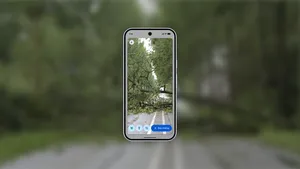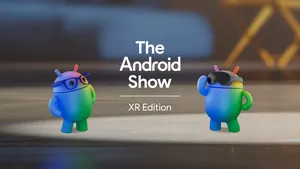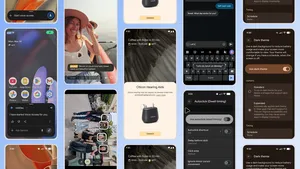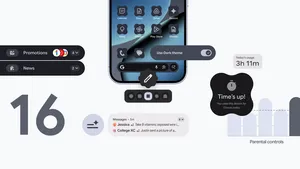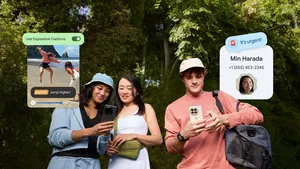10 fun facts about emoji for World Emoji Day

Happy World Emoji Day! You didn’t think we’d let such a momentous occasion pass without a bit of fanfare 🎉, did you 😉? And there’s a lot to celebrate. For starters, new emoji are on the way. To mark the day, we’re sharing more details on that tidbit, plus nine more fun facts about emoji — you might just learn a thing or 2️⃣.
1. A new batch of emoji are on the way

As part of the Unicode 16.0 release, there will be seven new additions in total: a fingerprint, leafless tree, harp, splat, face with bags under eyes, shovel and root vegetable. (Unicode is an international encoding standard that digitizes the world's languages.) These new emoji will be available as a web font in both color and monochrome this September, on Android phones by March 2025 and in your favorite Google products in early 2025.
2. Emoji creation doesn’t happen overnight

It can take one to two years for an emoji to go from an idea to landing on your keyboard. And once an emoji becomes part of the Unicode Standard, it can’t be removed — which is why there’s such a high benchmark for emoji induction. The Emoji Subcommittee works with experts around the world to identify common ways we express ourselves historically in literature, film, media and pop culture. This has led to the encoding of some particularly creative emoji: 🥹🫠🫥🫡❤️🩹, to name a few.
3. Emoji Kitchen has grown a ton in four years

In 2020, Emoji Kitchen first launched in Android using Gboard. It featured a couple thousand hand-drawn stickers that each combined two emoji. The goal was to help users find more nuanced ways to express themselves. These mashups can help you express those ambiguous spaces between feelings — like when you’re both happy and sad, or you’re feeling like a triumphant clown. And now, Emoji Kitchen features more than 100,000 drawings to help capture your vibe.
4. Emoji Kitchen is available via Google Search
Type “emoji kitchen” in the Search bar and smash “Get cooking.” Starting today, you’ll see a pop-up with two tabs: a “combine” tab where you can mix any two individual emoji of your choosing, and a new “explore” tab where you can select any single emoji and see how it would combine with any other single emoji. Browse the “recipes” for some inspiration!
5. YouTube Shorts’ new Emoji Kitchen Effect is coming soon
In a few weeks, a new Emoji Kitchen Effect will be available on YouTube Shorts. A couple tilts of the head and boom — you’ve got a frog bread sticker!
6. You can customize lists and react to photos in Google Maps with emoji

You can use emoji to customize your Google Maps lists with the icon of your choosing, like 🍕for your favorite slice shops, so the places you save are identified with that emoji on your map. You can also use emoji to react to the photos you see on Google Maps. Browsing a restaurant listing and see a picture of a bagel you can’t wait to try? Just tap to react with animated emoji. In some cases, Maps will even use AI and Emoji Kitchen to determine what’s in the photo, and create a custom emoji to react with.
7. You can create custom emoji wallpaper on Android devices
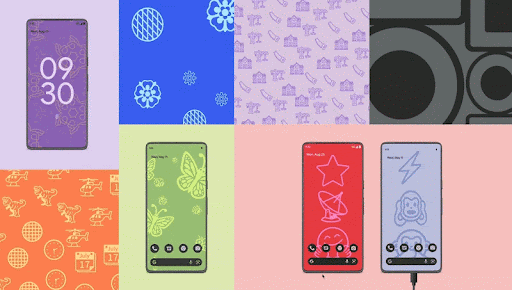
With Emoji Workshop, available on Android devices, you can choose up to 14 emoji to decorate your phone’s wallpaper, or you can have your phone populate a randomized assortment of emoji for your wallpaper instead. Either way, you can tweak the pattern the emoji appear in, along with a wallpaper color that best fits your creation. Even better, the emoji are responsive and change in the moment to signal something important, like when you get a phone call.
8. Emoji Kitchen combinations can function like language…

Emoji Kitchen combos work similarly to the way we play with words, so your phone’s keyboard becomes an even richer canvas for expression. (Think of portmanteaus like “brunch” or nouns that turn into verbs, à la “email.”) Many emoji are encoded in a manner that is literally combining two emoji together. For example, the heart on fire emoji is a combination of heart and fire codepoints. These sequences of characters create what’s called a “glyph” and are referred to in the typography business as a “zwj sequence.”
9. …But emoji are actually a font

Surprise! While emoji look like tiny pictures, they are technically a font. Google’s emoji font is called Noto. (Noto stands for “No Tofu.” Tofu is what we call those weird boxes that sometimes appear in messages instead of emoji or text.) You can download Noto for free here.
10. You can change the skin tone and gender expression of an emoji with one tap
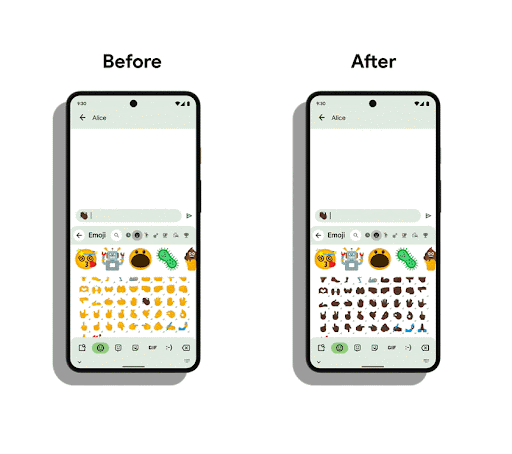
Instead of setting the skin tone and gender expression of your emoji individually, changing one now changes all other compatible emoji. This can help you spend less time changing these aspects of your emoji one by one — and more time truly expressing yourself instead.

